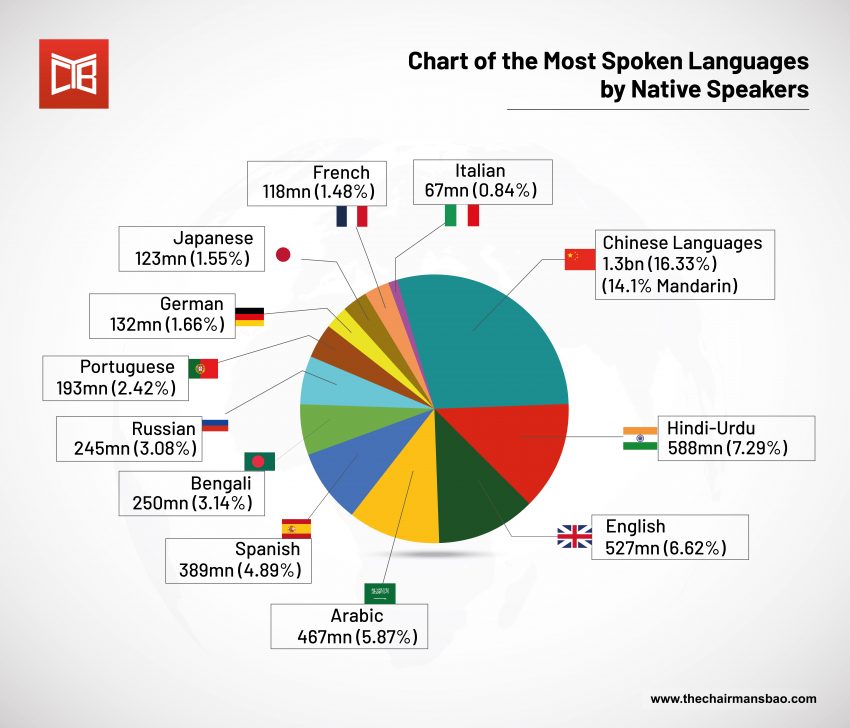
What is the most spoken language in the world?
Chinese is the most spoken group of languages in the world, with over 1.3 billion native speakers. The world’s most spoken native language is Mandarin Chinese, which accounts for 1.12 billion native speakers. The second most spoken native language in the world is Hindi-Urdu, with 588 million native speakers. The third most spoken language in the world is English, with 527 million native speakers. English is the most studied language in the world. For this reason, the most spoken language including both first and foreign language speakers in the world is English, with 1.13 billion people.
How many people speak Chinese?
There are over 1.3 billion native speakers of Chinese languages, a group which is made up of over 300 distinct languages. According to Ethnologue, 292 languages are still spoken daily in China, but many others are already extinct. The Chinese Government recently launched a campaign to promote the study and use of Mandarin across the country, with the target that more than 85% of the population in China will speak Mandarin by 2025.
The most spoken languages in China
The top eight spoken groups of Chinese language are listed below. Although the varieties of Chinese languages are grouped, each variety can be made up of many languages and they are not always mutually intelligible. Take Wu Chinese, for example, of which Shanghainese is one of the languages. Suzhou dialect is usually taken as the representative language of Wu Chinese, as Shanghainese features many anomalies that make it difficult to understand even for people who speak another native language within the Wu language group!
- Standard Mandarin. Mandarin is the most spoken language in China. Mandarin was traditionally spoken in the north and southwest of China. It includes the Beijing dialect, which is commonly known as ‘Standard Chinese’ and is used for official communication in China. Mandarin is the official language in China today and is taught at schools throughout the country. Mandarin is also one of the world’s most growing languages foreign languages to study, due to China’s influence in global markets and trade. Mandarin is the native language of 65.7% of people in China, but is spoken by many more as a second language.
- Wu. If you have visited Shanghai, you will be familiar with the Wu varieties of Chinese language. Shanghainese is a version of the Wu group of languages and they feature prominently in Jiangsu, Zhejiang and Ansu. Wu languages are spoken by 6.1% of the population in China.
- Yue (Cantonese). Yue varieties of Chinese language are spoken in Guangdong, Guanxi, Hong Kong and Macau. The most commonly spoken variety of Yue Chinese is Cantonese, which originated in Guangzhou (historically known as ‘Canton’). Did you know that the Cantonese language has nine tones, whereas Mandarin features just five? Cantonese is an extremely rich and poetic language. Yue languages are spoken by 5.6% of the population in China.
- Jin. Variations of Jin are spoken most commonly in Central China. The Jin variations of Chinese language were originally included within the Mandarin language group, but were later recategorized due to the retention of the checked tone. Jin languages are natively spoken by 5.2% of China’s population.
- Gan. Gan Chinese is spoken in south-eastern China (in places such as Jiangxi Province). Gan Chinese is considered to be most closely associated to Hakka Chinese. Gan Chinese varieties are the native languages of 3.9% of the population in China.
- Hakka. Hakka Chinese originated from northern China, but many of the speakers were displaced due to war and poverty during the Song Dynasty. Speakers of Hakka fled to southern China and the dialect is still known today as Kejia (literally ‘guest families’) because of this. Hakka Chinese has spread far and wide and its variations are spoken throughout Taiwan, Indonesia, Singapore and Hong Kong. Hakka varieties are the native languages of 3.5% of people in China.
- Xiang. Xiang variations of Chinese language are spoken throughout Hunan and Hubei. There are over 37 million speakers of Xiang Chinese. Xiang varieties are spoken natively by 3% of China’s population.
- Huizhou. Huizhou varieties of Chinese language are spoken in Anhui, Zhejiang and Jiangxi. Huizhou varieties are the native languages of just 0.3% of the population in China.
The world’s most spoken languages by number of native speakers
- Chinese languages – 1.3 billion
- Hindi-Urdu – 588 million
- English – 527 million
- Arabic – 467 million
- Spanish – 389 million
- Bengali – 250 million
- Russian – 245 million
- Portuguese – 193 million
- German – 132 million
- Japanese – 123 million
- French – 118 million
- Italian – 67 million
The world’s most spoken native languages by % of the global population
- Chinese languages – 16.33% (14.1% Mandarin)
- Hindi-Urdu – 7.29%
- English – 6.62%
- Arabic – 5.87%
- Spanish – 4.89%
- Bengali – 3.14%
- Russian – 3.08%
- Portuguese – 2.42%
- German – 1.66%
- Japanese – 1.55%
- French – 1.48%
- Italian – 0.84%
Chart of the most spoken languages by native speakers and percentage of global population
What percentage of the world’s population speaks Chinese?
Over 16% of the world’s population speak a form of Chinese language natively, which make Chinese languages the most spoken by native speakers around the world. There are over 7,100 languages spoken around the world today but incredibly more than 80% of languages are spoken by less than 100,000 native speakers. In a more globalized world, it is important that we preserve the use of lesser-spoken languages for future generations and there are many campaigns globally to ensure their survival. The introduction of online language learning platforms has given support to such initiatives. As an example, Irish Gaelic is spoken by just under 140,000 native speakers, but over one million people are learning Irish Gaelic with online resources!
Is Chinese difficult to learn?
The world’s most spoken language, Mandarin Chinese, has long been considered one of the most difficult languages to learn in the world. Complexities of the writing system and tones in Chinese are enough for people to write off learning before they have even tried. Despite these (initially) daunting factors, there are many reasons why learning Chinese isn’t as difficult as you may think! The British Council lists Mandarin Chinese as the fourth most important ‘Language for the Future’, so there has never been a better time to learn. It’s also a great language to help your resume stand out!
Reasons why learning Chinese isn’t as hard you think
- Chinese grammar is simple. There are no verb conjugations in Chinese and you also don’t need to worry about tenses. Sentences in Chinese are easy construct. Take the English phrase ‘I’m going to go to the shop tomorrow’. In Chinese, this would be constructed as ‘tomorrow I go shop’. Constructing sentences in Chinese can be seen as placing building blocks, without many of the other complexities that come with studying more traditionally learnt languages.
- Chinese characters just make sense! Chinese characters are made up of elements called radicals. You can think of them as the base components of each character. There are around 200 radicals that are in common use in Chinese and you can learn them easily. Radicals give you information about the meaning of characters and their pronunciation, so can go a long way to improving your understanding in Chinese.
- No genders. In Chinese, you don’t assign genders to nouns as you would in many other languages such as French and Spanish. There is also no grammatical gender in Chinese. In spoken Chinese, ‘he’, ‘she’ and ‘it’ are all said as ‘ta’, so there is no need to differentiate. That’s one less thing to worry about when learning Chinese!
- Logical number system. The Chinese number system is easy to learn as its construction makes sense. The numbers one to 10 are all single-syllabled. Larger numbers are also simple to construct in Chinese. For example, to say 4,255 you would split it as ‘4 1000 2 100 5 10 5’.
- There are great resources to learn Chinese online! Authentic online resources to learn Chinese such as The Chairman’s Bao mean that daily, manageable study through topics you enjoy is now a real possibility even when just starting out on your Chinese learning journey.
Author:
Sean McGibney speaking to students at Beths Grammar School about his experience of learning Chinese, living in China and founding Newsdle and The Chairman’s Bao.
Sean studied Chinese and Spanish at University of Leeds and founded The Chairman’s Bao alongside Tom Reid in his final year of study in 2015. Current Managing Director of The Chairman’s Bao, he has overseen the company’s growth from university bedroom concept to an international force in the EdTech industry with over 200,000 individual users and over 400 global partner institutions. Sean also launched Newsdle alongside Tom Reid and Oliver Leach in 2021, for students and teachers of Spanish and French. In his spare time, Sean is still a keen language learner and runner. He also sits on the Board of charity Leeds Irish Health and Homes in the UK.
Sources:
- Population Reference Bureau
- Wikipedia
- Ethnologue
- Index Mundi
- CIA World Factbook
- United Nations
- British Council

























